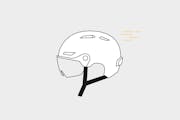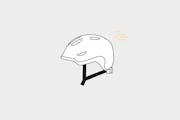Purchasing a cycling helmet: how to find the right one
Should you go for a helmet with a visor, one with a built-in light or a cycling helmet with plenty of ventilation vents? If you’re looking to buy a cycling helmet, you’ll find an overview of different models and tips on how to find the right helmet for you here.
A cycling helmet only offers optimal protection if it fits, which is why it’s important to get the information you need before you buy. And since every head is shaped differently, you should definitely try the helmet on. It’s great if you like the look of the helmet – but for the sake of your head, make sure you place more importance on the fit than the design.
Below are the most important tips for buying a bike helmet. Additionally, in the overview you can see which helmet models are available.
Comparing different helmets
If you’re primarily riding your bike in the city, you’ll need a different helmet than someone riding a mountain bike down steep trails. And while helmets with visors are recommended for riding e-bikes, for example, well-ventilated helmets are more suitable for gravel bike tours. Below, you’ll find an overview of different models.

Touring and city cycling helmets
These helmets are cut slightly deeper above the ears and at the back of the head and offer good protection. Some have a small visor at the front, also known as the umbrella, which protects you from the sun and rain. There are also models with built-in lights – but be careful: this is not a replacement for the light required on the bicycle itself. Most of the time, these general purpose helmets are relatively inexpensive.

Helmets for e-bikes
You’re travelling at high speeds – so a sturdy helmet with a visor is worth it. The cycling helmet must be able to withstand the higher speed and impact. Helmets for e-bikes therefore tend to be slightly larger and heavier. At high speeds, eyes tend to start to water quickly – a built-in visor protects the eyes from wind, insects or kicked-up dust. However, air vents are less important, because you sweat less quickly on an e-bike compared to a conventional bike.

Helmets for racing or gravel bikes
These types of helmets are lighter than others and provide particularly good ventilation, with large ventilation slots. They’re also streamlined and usually don’t have a visor.

Mountain bike helmet
Falls are more common on a mountain bike than when cycling on flat terrain. That’s why the helmets are more robust: the helmet shell extends to just above the ears at the sides and back, or almost down to the neck. Plus, a fixed visor ensures that the sun doesn’t blind you, the rain doesn’t affect your vision and that branches don’t get into your eyes.

Bike helmets for children
Children are often even less safe on bicycles than adults, which is why their heads needs special protection. Most helmets for children therefore protect the forehead and the sides and back of the head, almost down to the neck. It’s worth buying a suitable helmet for children, even if they’ll grow out of it quickly. It’s important that the helmet is also comfortable when the child is leaning against the back of their head, for example when in a trailer. Finally, brightly coloured helmets offer greater visibility in road traffic. But it’s also essential to keep in mind that the child should like the helmet, so that they enjoy wearing it.
The best way to store your cycling helmet
As with almost all outdoor equipment, the following applies to cycling helmets: store them in a dry, dark place away from direct sunlight, at as constant a temperature as possible. This prevents the material from wearing out. But even with good storage, you should replace your helmet regularly. According to manufacturers, cycling helmets usually last between three to five years. Among other factors, this depends on how often you use it and whether you have fallen with the helmet before. If there are visible dents and scratches, you should definitely replace your cycling helmet. It’s important to know that even if the helmet is not visibly damaged, the material is damaged by falls and normal use.
Rent cycling equipment
You can rent bikepacking bags or even a tent and a sleeping mat for your bike tour from Transa. Although it makes sense to rent or buy second-hand equipment you don’t need regularly, when it comes to cycling helmets, we advise you not to. You don’t know how old the helmet is, how many falls it’s taken or how many times it's been dropped – maybe there’s no visible signs of wear, but the material may still be damaged. That’s why it’s worth buying your own cycling helmet new, even if you’re using it infrequently.
What does Mips stand for?
Many cycling helmets have a round, bright yellow sticker with the word ‘Mips’. This stands for ‘multi-directional impact protection system’. Due to their design, helmets with this label offer particularly good protection in the event of a side impact, while a helmet without Mips stops any rotational movement very suddenly on impact, increasing the risk of a skull or brain injury. With Mips, the head brakes more gently due to a built-in sliding span inside. Whether or not your helmet is fitted with Mips, it must comply with the European safety standard EN 1078. All Transa helmets have this safety seal.
Do you have any questions?
Get personal advice from our sales advisors in the shops or online and over the phone from customer service. We'll be happy to help you.
- Free shipping from CHF 99
(With the TransaCard always free of charge)
- Secure payment with Twint, Visa and more
- 14 days cancellation right



